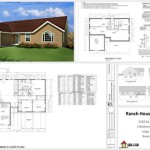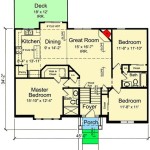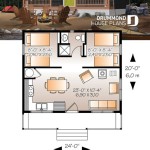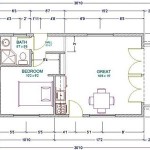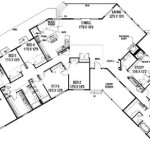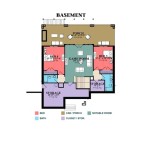Home Plans With Basement Apartment: Maximizing Space and Value
Home plans with basement apartments represent a strategic approach to residential design, offering homeowners the potential to simultaneously increase living space, generate income, and enhance property value. These plans involve incorporating a self-contained living unit within the basement of a house, complete with its own entrance, kitchen, bathroom, and sleeping area. The increasing popularity of this design stems from its practicality and versatility, addressing diverse needs ranging from accommodating extended family to providing rental income.
The incorporation of a basement apartment into a home plan necessitates careful consideration of various factors, including local zoning regulations, building codes, and the specific needs and preferences of both the homeowner and potential tenants. A well-designed basement apartment can seamlessly integrate into the overall structure of the house, providing a comfortable and private living space without compromising the functionality or aesthetics of the main dwelling.
Home plans with basement apartments range from simple, cost-effective layouts to more elaborate designs with high-end finishes and amenities. The complexity and features of the apartment are often dictated by budget constraints, intended use (e.g., rental versus family use), and the existing structural characteristics of the basement. Regardless of the specific design, careful planning and execution are crucial to ensure that the basement apartment is safe, functional, and compliant with all applicable regulations.
Key Benefits of Home Plans with Basement Apartments
One of the primary advantages of incorporating a basement apartment into a home plan is the potential for generating rental income. This income can be used to offset mortgage payments, property taxes, or other household expenses. In areas with high rental demand, a well-maintained basement apartment can provide a consistent and reliable source of revenue. The profitability of a basement apartment as a rental unit depends on factors such as location, size, amenities, and market rates.
Another significant benefit is the flexibility it provides in terms of accommodating extended family members. Homeowners can use the basement apartment to house aging parents, adult children, or other relatives, allowing them to maintain their independence while remaining close to family. This arrangement can provide valuable support and companionship for both the homeowner and the family members living in the apartment. The apartment also provides a degree of privacy and autonomy that might be lacking in a more traditional shared living arrangement.
Finally, adding a basement apartment can increase the overall value of a home. Potential buyers may be attracted to the property's income-generating potential or the flexibility it offers for accommodating diverse living arrangements. A well-designed and maintained basement apartment can significantly enhance the resale value of the home, making it a worthwhile investment for homeowners looking to improve their property's long-term value. The increase in value is, of course, dependent on the quality of the construction, the desirability of the location, and the overall market conditions.
Design Considerations for Basement Apartments
The design of a basement apartment requires careful attention to several key considerations. These include ensuring adequate natural light and ventilation, addressing moisture control issues, and providing a safe and accessible entrance and egress. The design must also comply with all applicable building codes and regulations, including those related to fire safety, accessibility, and energy efficiency.
Natural light and ventilation are essential for creating a comfortable and livable basement apartment. Since basements are typically located below ground level, they often lack sufficient natural light. To address this, designers may incorporate larger windows, light wells, or even walk-out access to the outdoors. Proper ventilation is also crucial for preventing moisture buildup and ensuring good air quality. This can be achieved through the installation of exhaust fans, dehumidifiers, and strategically placed windows or vents.
Moisture control is another critical consideration in basement apartment design. Basements are prone to moisture issues due to their proximity to the ground. To prevent moisture intrusion, it is essential to properly waterproof the foundation walls and install a reliable drainage system. Adequate insulation can also help to prevent condensation and maintain a comfortable temperature in the apartment. Addressing moisture issues proactively is essential for preventing mold growth and maintaining a healthy living environment.
Providing a safe and accessible entrance and egress is paramount for basement apartment design. The apartment must have its own separate entrance to ensure privacy and independence for the occupants. This entrance should be well-lit and easily accessible, even in inclement weather. Additionally, the apartment must have at least two means of egress in case of fire or other emergencies. This typically includes a primary exit door and a secondary exit, such as a window or walk-out access.
Compliance with building codes and regulations is non-negotiable when designing a basement apartment. These codes and regulations are designed to ensure the safety and well-being of the occupants and to protect the integrity of the building. Homeowners should consult with local building officials and qualified professionals to ensure that their basement apartment design meets all applicable requirements. Failure to comply with building codes can result in fines, delays, and even the revocation of permits.
Legal and Regulatory Requirements for Basement Apartments
The construction and operation of a basement apartment are subject to various legal and regulatory requirements, which can vary depending on the location. These requirements may include zoning regulations, building codes, and landlord-tenant laws. Homeowners must be aware of these requirements and ensure that their basement apartment complies with all applicable laws and regulations.
Zoning regulations often dictate whether or not basement apartments are permitted in a particular area. Some zoning districts may prohibit basement apartments altogether, while others may allow them subject to certain conditions. These conditions may include restrictions on the size of the apartment, the number of occupants, or the availability of off-street parking. Homeowners should consult with their local zoning department to determine whether basement apartments are permitted in their area and what conditions apply.
Building codes establish minimum standards for the construction and alteration of buildings. These codes cover a wide range of topics, including structural integrity, fire safety, electrical systems, plumbing, and accessibility. Basement apartments must comply with all applicable building codes to ensure the safety and well-being of the occupants. It is essential to obtain the necessary permits and inspections before beginning construction to ensure compliance with building codes.
Landlord-tenant laws govern the relationship between landlords and tenants. These laws cover a wide range of topics, including lease agreements, rent payments, security deposits, eviction procedures, and tenant rights. Homeowners who rent out their basement apartment must comply with all applicable landlord-tenant laws. This includes providing a written lease agreement, maintaining the property in a habitable condition, and respecting the tenant's right to privacy.
In addition to zoning regulations, building codes, and landlord-tenant laws, there may be other legal and regulatory requirements that apply to basement apartments. These may include requirements related to fire safety, accessibility for individuals with disabilities, and environmental protection. Homeowners should consult with qualified professionals to ensure that their basement apartment complies with all applicable legal and regulatory requirements.
The thorough investigation and adherence to these local regulations are crucial for avoiding potential legal complications and ensuring the long-term viability of the basement apartment as a legitimate and compliant living space. Non-compliance can lead to significant fines, legal battles, and even the forced closure of the apartment.
The design, construction, and operation of a basement apartment require careful planning and execution. By carefully considering the factors discussed above and complying with all applicable regulations, homeowners can create a comfortable, safe, and valuable addition to their property. The key is to approach the project with a well-thought-out plan, a commitment to quality workmanship, and a thorough understanding of the legal and regulatory landscape.

House Plans Floor W In Law Suite And Basement Apartement

House Plans Floor W In Law Suite And Basement Apartement

Basement Apartment Floor Plan Ideas Google Search Planos De Apartamentos Construcción Plano Apartamento

Basement Floor Plans Types Examples Considerations Cedreo

Small Basement Layout Home Floor Plans

House Plans Floor W In Law Suite And Basement Apartement

Basement Floor Plans

Versatile Spacious House Plans With Basements Houseplans Blog Com

Small Cottage Plan With Walkout Basement Floor

Simple House Floor Plans 3 Bedroom 1 Story With Basement Home Design 1661 Sf Ranch

